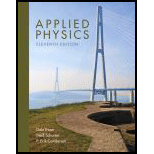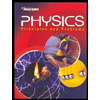
Applied Physics (11th Edition)
11th Edition
ISBN: 9780134159386
Author: Dale Ewen, Neill Schurter, Erik Gundersen
Publisher: PEARSON
expand_more
expand_more
format_list_bulleted
Concept explainers
Textbook Question
Chapter 5, Problem 9RP
A rock of a mass 13.0 kg is dropped from a cliff. Find its weight.
Expert Solution & Answer
Want to see the full answer?
Check out a sample textbook solution
Chapter 5 Solutions
Applied Physics (11th Edition)
Ch. 5.2 - Find the total force necessary to give each mass...Ch. 5.2 - Find the total force necessary to give each mass...Ch. 5.2 - Find the total force necessary to give each mass...Ch. 5.2 - Find the total force necessary to give each mass...Ch. 5.2 - Find the total force necessary to give each mass...Ch. 5.2 - Find the total force necessary to give each mass...Ch. 5.2 - Find the total force necessary to give each mass...Ch. 5.2 - Find the total force necessary to give each mass...Ch. 5.2 - Find the acceleration of each mass with the given...Ch. 5.2 - Find the acceleration of each mass with the given...
Ch. 5.2 - Find the acceleration of each mass with the given...Ch. 5.2 - Find the acceleration of each mass with the given...Ch. 5.2 - Find the acceleration of each mass with the given...Ch. 5.2 - Find the acceleration of each mass with the given...Ch. 5.2 - Find the acceleration of each mass with the given...Ch. 5.2 - Find the acceleration of each mass with the given...Ch. 5.2 - Find the acceleration of each mass with the given...Ch. 5.2 - Find the acceleration produced by a total force of...Ch. 5.2 - Find the total force necessary to give an...Ch. 5.2 - Find the total force necessary to give a rocket of...Ch. 5.2 - A forklift has a mass of 975 kg. What force must...Ch. 5.2 - A power wheelbarrow has a mass of 432 kg. What...Ch. 5.2 - What is the rate of deceleration of a 1400-kg SUV...Ch. 5.2 - An earthmover slows from 15.0 km/h to 3.00 km/h in...Ch. 5.2 - Find the total force necessary to give a 140-kg...Ch. 5.2 - Find the acceleration produced by a total force of...Ch. 5.2 - Find the mass of an object with acceleration 15.0...Ch. 5.2 - An automobile has a mass of 100 slugs. The...Ch. 5.2 - Find the acceleration produced by a force of 6.75 ...Ch. 5.2 - An astronaut has a mass of 80.0 kg. His space suit...Ch. 5.2 - A discus thrower exerts a force of 140 N on the...Ch. 5.2 - A scooter and rider together have a mass of 275...Ch. 5.2 - A pickup truck with mass of 1230 kg moving at 105...Ch. 5.3 - Find the weight for each mass. 1. m = 30. 0kgCh. 5.3 - Find the weight for each mass. 2. m = 60.0kgCh. 5.3 - Find the weight for mass. 3. m = 10.0 slugsCh. 5.3 - Find the weight for each mass. 4. m = 9.00 kgCh. 5.3 - Find the mass for each weight. 5. Fw = 17.0 NCh. 5.3 - Find the mass for each weight. 6. Fm = 21.0 lbCh. 5.3 - Find the mass for each weight. 7. Fw = 12,000 NCh. 5.3 - Find the mass for each weight. 8. Fw = 25, 000 NCh. 5.3 - Find the mass for the each weight. 9. Fw = 6.7 ...Ch. 5.3 - Find the mass for each weight. 10. Fw = 5.5 106...Ch. 5.3 - Find the weight of an 1150-kg automobile.Ch. 5.3 - Find the weight of an 81.5-slug automobile.Ch. 5.3 - Find the mass of a 2750-lb automobile.Ch. 5.3 - What is the mass of a 20,000-N truck?Ch. 5.3 - What is the mass of a 7500-N trailer?Ch. 5.3 - Find the mass of an 11,500-N automobile.Ch. 5.3 - Find the weight of a 1350-kg automobile (a) on the...Ch. 5.3 - Maria weighs 115 lb on the earth. What are her (a)...Ch. 5.3 - Johns mass is 65.0 kg on the earth. What are his...Ch. 5.3 - What is your weight in newtons and in pounds?Ch. 5.3 - What is your mass in kilograms and in slugs?Ch. 5.3 - What are your U.S. mass and weight on the moon?Ch. 5.3 - What are your metric mass and weight on the moon?Ch. 5.3 - Johns mass is 65.0 kg on the earth. What are his...Ch. 5.3 - Maria weighs 115 lb on the earth. What are her U...Ch. 5.3 - John's mass is 65.0 kg on the earth. What are his...Ch. 5.3 - What are your metric mass and weight on Jupiter,...Ch. 5.3 - What are your metric mass and weight on Mars,...Ch. 5.3 - An automobile transmission weighs 995 N. What is...Ch. 5.3 - A power wheelbarrow weighs 210 N. What is its...Ch. 5.4 - A cart on wheels weighs 2400 N. The coefficient of...Ch. 5.4 - A wooden crate weighs 780 lb. What force is needed...Ch. 5.4 - A piano weighs 4700 N. What force is needed to...Ch. 5.4 - A force of 850 N is needed to keep the piano in...Ch. 5.4 - A dog sled weighing 750 lb is pulled over level...Ch. 5.4 - A horizontal conveyor belt system has a...Ch. 5.4 - A tow truck can deliver 2500 lb of pulling force....Ch. 5.4 - A snowmobile is pulling a large sled across a...Ch. 5.4 - An automobile weighs 12,000 N and has a...Ch. 5.4 - A light truck weighs 14,000 N with a coefficient...Ch. 5.4 - A stake truck weighs 20,000 N with a coefficient...Ch. 5.4 - An alloy block is placed on a smooth composite...Ch. 5.4 - If a 20.0-N casting is placed on the block in...Ch. 5.4 - Rubber tires and wet blacktop have a coefficient...Ch. 5.4 - The coefficient of friction in Problem 15 is 0.700...Ch. 5.5 - Find the net force including its direction when...Ch. 5.5 - Find the net force including its direction when...Ch. 5.5 - Find the net force including its direction when...Ch. 5.5 - Find the net force including its direction when...Ch. 5.5 - Find the net force including its direction when...Ch. 5.5 - Find the net force including its direction when...Ch. 5.5 - Find the acceleration of an automobile of mass 100...Ch. 5.5 - Find the acceleration of an automobile of mass...Ch. 5.5 - A truck of mass 13,100 kg is acted upon by a...Ch. 5.5 - A speedboat of mass 30.0 slugs has a 300-lb force...Ch. 5.5 - A truck with a mass of 14,000 kg is pushed with a...Ch. 5.5 - A trailer has a mass of 5000 kg. It is pulled by a...Ch. 5.5 - A refrigeration unit on a job site must be slid...Ch. 5.5 - A light truck of 2000-kg mass has to be pushed...Ch. 5 - Force a. is a vector quantity. b. may be different...Ch. 5 - The metric weight of a 10-lb bag of sugar is...Ch. 5 - Mass and weight a. are the same. b. are different....Ch. 5 - According to Newtons second law, the law of...Ch. 5 - Friction a. always acts parallel to the surface of...Ch. 5 - Cite three examples of forces acting without...Ch. 5 - Using your own words, state Newton's first law,...Ch. 5 - Distinguish between velocity and acceleration.Ch. 5 - When the same force is applied to two different...Ch. 5 - Is 3 lb heavier than 10 N?Ch. 5 - Explain how life would be easier or more difficult...Ch. 5 - Explain how the weight of an astronaut is...Ch. 5 - Explain the difference between action and reaction...Ch. 5 - State Newton's third law of motion, the law of...Ch. 5 - A crate of mass 6.00 kg is moved by a force of...Ch. 5 - An 825-N force is required to pedal a bike with an...Ch. 5 - A block of mass 0.89 slug moves with a force of...Ch. 5 - What is the force necessary for a 2400-kg truck to...Ch. 5 - Two movers push a piano across a frictionless...Ch. 5 - A 340-N box has a frictional force of 57 N. Find...Ch. 5 - A truck pulls a trailer with a frictional force of...Ch. 5 - A steel box is slid along a steel surface. It has...Ch. 5 - A rock of a mass 13.0 kg is dropped from a cliff....Ch. 5 - A projectile has a mass of 0 37 slug. Find its...Ch. 5 - What force is required to produce an acceleration...Ch. 5 - Find the total force necessary to give a 280-kg...Ch. 5 - A force of 175 N is needed to keep a 640 -N...Ch. 5 - A crated garden tractor weighs 375 N. What force...Ch. 5 - Find the acceleration of a forklift of mass 1400...Ch. 5 - What is the weight of a 375-kg air compressor?Ch. 5 - What is the mass of a 405-N welder?Ch. 5 - What is the mass of a 12.0-N hammer?Ch. 5 - Engineers at Boeing developing specs for their...Ch. 5 - The Apollo spacecrafts were launched toward the...Ch. 5 - Kirsten's mass is 373 slugs. Being the physics fan...Ch. 5 - A motorcycle racer travelling at 145 km/h loses...Ch. 5 - The motorcycle and rider are sliding with the same...
Additional Science Textbook Solutions
Find more solutions based on key concepts
61. Trucks often have signs on the back that say, “If you see my mirrors, I can’t see you.” Explain the physics...
Conceptual Physical Science (6th Edition)
48. A copper block is removed from a 300°C oven and dropped into 1.00 kg of water at 20.0°C. The water quickly ...
College Physics: A Strategic Approach (4th Edition)
A 4.00-pF is connected in series with an 8.00-pF capacitor and a 400-V potential difference is applied across t...
University Physics Volume 2
3. What is free-fall, and why does it make you weightless? Briefly describe why astronauts are weightless in th...
The Cosmic Perspective (8th Edition)
Atmospheric Mass of Earth. What is the total mass of Earth’s atmosphere? Use the fact that, under Earth’s gravi...
Life in the Universe (4th Edition)
S
10. FIGURE EX6.10 shows the velocity graph of a 2.0 kg object as it moves along the x-axis. What is the net ...
Physics for Scientists and Engineers: A Strategic Approach with Modern Physics (4th Edition)
Knowledge Booster
Learn more about
Need a deep-dive on the concept behind this application? Look no further. Learn more about this topic, physics and related others by exploring similar questions and additional content below.Similar questions
- What is the condition for motion when more than one force acts?arrow_forwardThe two barges shown here are coupled by a cable of negligible mass. The mass of the front barge is 2.00103kgand the mass of the rear barge is 3.00103kg . A tugboat pulls the front barge with a horizontal force of magnitude 20.0103N . and the frictional forces of the water on the front and rear barges are 8.00103Nand 10.0103N . respectively. Find the horizontal acceleration of the barges and the tension in the connecting cable.arrow_forwardA net force can produce ___. (3.3) (a) an acceleration (b) a change in velocity magnitude (c) a change in velocity direction (d) all of the precedingarrow_forward
- A large crate of mass m is placed on the flatbed of a truck but not tied down. As the truck accelerates forward with acceleration a, the crate remains at rest relative to the truck. What force causes the crate to accelerate? (a) the normal force (b) the gravitational force (c) the friction force (d) the ma force exerted by the crate (e) No force is required.arrow_forwardA force is a quantity that is ___ of producing motion or a change in motion. (3.1)arrow_forwardThree forces F1=(62.98i15.80j) N, F2=(23.66i78.05j) N, and F3=(86.64i+233.4j) N are exerted on a particle. The particles mass is 14.23 kg. Find the particles acceleration.arrow_forward
- Three forces act on an object, considered to be a particle, which moves with constant velocity . Two of the forces are and . Find the third force.arrow_forwardMass is related to an objects ___. (3.3) (a) weight (b) inertia (c) density (d) all of the precedingarrow_forwardCalculate the force required to pull a stuffed toy duck (mass m = 1.25 kg) at a constant velocity of 3.6 m/s horizontally across the floor if the string is 50.0 above the horizontal. The coefficient of kinetic friction between the duck and the floor is 0.70.arrow_forward
- A block slides down a frictionless plane having an inclination of 15.0. The block starts from rest at the top. and the length of the incline is 2.00 m. (a) Draw a free-body diagram of the block. Find (b) the acceleration of the block and (c) its speed when it reaches the bottom of the incline.arrow_forwardKinetic friction is proportional to the normal force (Eq. 5.9). Why should there be an intimate connection between these two forces?arrow_forwardChoose the best answer. A car traveling at constant speed has a net force of zero acting on it. (a) True (b) False (c) The answer depends on the motion.arrow_forward
arrow_back_ios
SEE MORE QUESTIONS
arrow_forward_ios
Recommended textbooks for you
 University Physics Volume 1PhysicsISBN:9781938168277Author:William Moebs, Samuel J. Ling, Jeff SannyPublisher:OpenStax - Rice University
University Physics Volume 1PhysicsISBN:9781938168277Author:William Moebs, Samuel J. Ling, Jeff SannyPublisher:OpenStax - Rice University An Introduction to Physical SciencePhysicsISBN:9781305079137Author:James Shipman, Jerry D. Wilson, Charles A. Higgins, Omar TorresPublisher:Cengage Learning
An Introduction to Physical SciencePhysicsISBN:9781305079137Author:James Shipman, Jerry D. Wilson, Charles A. Higgins, Omar TorresPublisher:Cengage Learning Physics for Scientists and Engineers, Technology ...PhysicsISBN:9781305116399Author:Raymond A. Serway, John W. JewettPublisher:Cengage Learning
Physics for Scientists and Engineers, Technology ...PhysicsISBN:9781305116399Author:Raymond A. Serway, John W. JewettPublisher:Cengage Learning Physics for Scientists and Engineers: Foundations...PhysicsISBN:9781133939146Author:Katz, Debora M.Publisher:Cengage Learning
Physics for Scientists and Engineers: Foundations...PhysicsISBN:9781133939146Author:Katz, Debora M.Publisher:Cengage Learning College PhysicsPhysicsISBN:9781305952300Author:Raymond A. Serway, Chris VuillePublisher:Cengage Learning
College PhysicsPhysicsISBN:9781305952300Author:Raymond A. Serway, Chris VuillePublisher:Cengage Learning Glencoe Physics: Principles and Problems, Student...PhysicsISBN:9780078807213Author:Paul W. ZitzewitzPublisher:Glencoe/McGraw-Hill
Glencoe Physics: Principles and Problems, Student...PhysicsISBN:9780078807213Author:Paul W. ZitzewitzPublisher:Glencoe/McGraw-Hill

University Physics Volume 1
Physics
ISBN:9781938168277
Author:William Moebs, Samuel J. Ling, Jeff Sanny
Publisher:OpenStax - Rice University

An Introduction to Physical Science
Physics
ISBN:9781305079137
Author:James Shipman, Jerry D. Wilson, Charles A. Higgins, Omar Torres
Publisher:Cengage Learning

Physics for Scientists and Engineers, Technology ...
Physics
ISBN:9781305116399
Author:Raymond A. Serway, John W. Jewett
Publisher:Cengage Learning

Physics for Scientists and Engineers: Foundations...
Physics
ISBN:9781133939146
Author:Katz, Debora M.
Publisher:Cengage Learning

College Physics
Physics
ISBN:9781305952300
Author:Raymond A. Serway, Chris Vuille
Publisher:Cengage Learning

Glencoe Physics: Principles and Problems, Student...
Physics
ISBN:9780078807213
Author:Paul W. Zitzewitz
Publisher:Glencoe/McGraw-Hill
Newton's First Law of Motion: Mass and Inertia; Author: Professor Dave explains;https://www.youtube.com/watch?v=1XSyyjcEHo0;License: Standard YouTube License, CC-BY